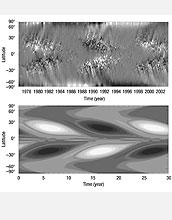|

Press Release 04-074
Scientist to Discuss Forecast of Sunspots

May 31, 2004
ARLINGTON, Va.—Using a new computer model of the Sun, scientists have begun work on a groundbreaking forecast of the next cycle of sunspots. Mausumi Dikpati of the National Center for Atmospheric Research (NCAR) in Boulder, Colo., will discuss the forecast for the upcoming "cycle 24" at next week's annual meeting of the American Astronomical Society (AAS) in Denver, Colo. Dikpati's talk is on Monday, May 31st. Predicting features of the solar cycle may help society anticipate sunspots and associated solar storms, which can disrupt communications and power systems and expose astronauts to high amounts of radiation.
The prediction draws on research by scientists at NCAR's High Altitude
Observatory. These researchers have found that that the evolution of sunspots is caused by a current of plasma, or electrified gas, that circulates between the Sun's
equator and its poles over a number of years. The forecasters believe the next solar cycle will begin in 2007 to 2008 if the plasma circulation, which has slowed down during the present solar cycle, continues to decelerate. That would mean that cycle 24 would begin about a half-year later than if the cycles followed the standard 11-year span.
"We will spend the next several months incorporating additional plasma flow data into our model to determine the rising pattern of cycle 24," explains Dikpati, a leader of the research team. "Our focus will be on when the cycle is likely to reach maximum and cause geomagnetic storms in Earth's atmosphere."
In addition to Dikpati, the team includes NCAR scientists Giuliana de Toma, Peter Gilman, and Oran White, as well as Nick Arge of the University of Colorado and the National Oceanic and Atmospheric Administration.
The NCAR team has received funding from the National Science Foundation (NSF) and NASA for its research.
The team's computer model, known as the Predictive Flux-transport Dynamo Model, successfully accounts for the 11-year duration of the solar cycle as well as such mysterious events as the reversal of the Sun's magnetic north and south poles that occurs toward the end of each solar cycle.
The research may represent a breakthrough in helping society better prepare for solar storms. It focuses on the meridional flow pattern of plasma, which circulates between the equator and the poles over a period of about 17 to 22 years and apparently transports imprints of sunspots that occurred over the previous two sunspot cycles.
By analyzing these past solar cycles, scientists hope eventually to forecast sunspot activity about two solar cycles, or 22 years, into the future.
The work also may have implications for understanding stars that have similar properties to the Sun. Observations have shown that the faster such stars rotate, the more disturbances they experience. This may indicate that the plasma flow on such stars is speeded up, thereby transporting sunspots more quickly and creating more stellar storms.
-NSF-

Media Contacts
,
Cheryl Dybas, NSF (703) 292-7734 cdybas@nsf.gov
Anatta , UCAR (303) 497-8604 anatta@ucar.edu

The National Science Foundation (NSF) is an independent federal agency that supports fundamental research and education across all fields of science and engineering. In fiscal year (FY) 2009, its budget is $9.5 billion, which includes $3.0 billion provided through the American Recovery and Reinvestment Act. NSF funds reach all 50 states through grants to over 1,900 universities and institutions. Each year, NSF receives about 44,400 competitive requests for funding, and makes over 11,500 new funding awards. NSF also awards over $400 million in professional and service contracts yearly.
 Get News Updates by Email Get News Updates by Email
Useful NSF Web Sites:
NSF Home Page: http://www.nsf.gov
NSF News: http://www.nsf.gov/news/
For the News Media: http://www.nsf.gov/news/newsroom.jsp
Science and Engineering Statistics: http://www.nsf.gov/statistics/
Awards Searches: http://www.nsf.gov/awardsearch/
| 

